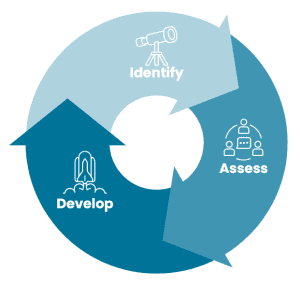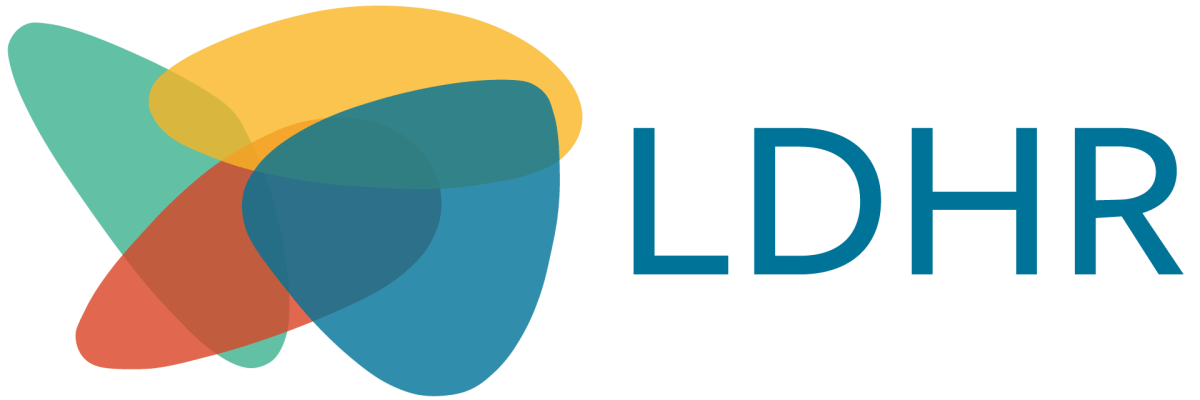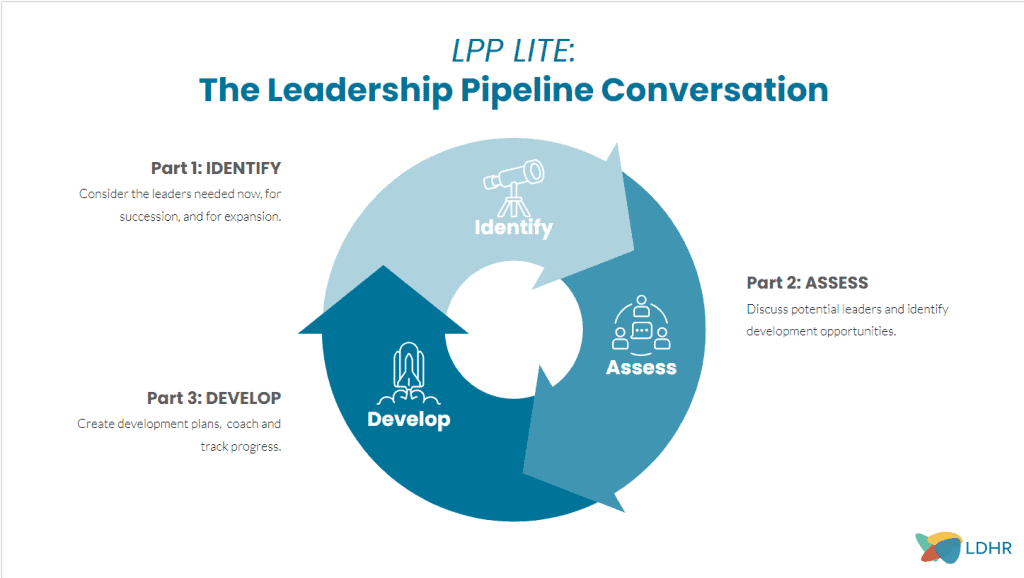
Leadership Pipeline Process
Our Leadership Pipeline Process consists of identifying what leaders you need, assessing the potential leaders you have, and developing them to effectively meet the leadership needs. It is most effective when completed on an annual basis.
There is also an LPP LITE version, conversation-focused and helpful for smaller ministries. (See tab below.)
When a new leader is needed, the pipeline helps form the pool of leaders needed for your Leadership Selection Process. When selected, the Leader Transition Process helps the new leader begin well in the new role.
Step 1
Step 2
Step 3
Identify your leadership needs.
Desired Outcome:
To engage the leadership team in generating and assessing a concise list of strategic leadership needs (both current and future) which includes both quantity and quality: the number of leaders needed by their specific roles and the non-negotiable skills or mindsets needed for each leadership role.
Key Process:
Leadership Needs Meeting
This meeting helps you to think strategically and seeks to answer the question, “What leaders do we need?” The senior leadership team sets aside at least one meeting per year to identify the organization’s leadership needs.
Many have found it helpful to conduct the annual Leadership Needs Meeting as part of their annual Strategic Planning Process, evaluating the people-implications of the strategy and goals.
Key Tool:
The Leadership Needs worksheet has been designed to help you identify your leadership needs in three different categories:
-
- Leaders needed currently for filling vacant roles
- Leaders needed because of succession – roles that you expect to become vacant because the current role holder is retiring or is expected to move to a new role either within or outside of the organization.
- Leaders needed because of expansion plans. In light of your strategic plan, roles that will be needed as you grow.
After identifying all the needs, the next step is to prioritize them, taking into account the urgency, the uniqueness of skills required, and the time required to develop those skills if needed. Please note: At this stage, you are not identifying the specific people who could fill the roles, but simply identifying the needs themselves.
Assess your potential leaders.
Desired outcome:
To engage the leadership team in assessing potential leaders and to identify those with the highest readiness and potential to step into specific roles. Each potential leader will have suggested steps for development, and a likely timeline for them to enter a potential leadership selection process.
This step seeks to answer the questions, “What potential leaders do we have?” and “Where do they need to grow?”
The Assess step works best when leaders at every level are regularly assessing their team member’s performance and leadership potential. It centers around an annual People Meeting where the leadership team reviews high-potential team members to assess their readiness and potential for increased leadership, discusses possible matches of potential leaders with leadership roles for the best fit, and gives input on needed development. This step helps meet leadership needs by ensuring that the right leader is placed in the right leadership position at the right time with the right preparation.
Key process:
People Meeting
The steps for the People Meeting include:
Before The Meeting
- Determine the leaders to be evaluated. This can be done by the leadership team, or possibly more helpful, ask team leaders and department heads to list them. Between 5 and 12 people being reviewed at one time is normal.
- For each of the potential leaders being assessed, have their immediate supervisor (or another appropriate leader) complete a Leader Profile.
- The facilitator of the process (usually the LDHR leader) then collects the Leader Profiles, compiles them and distributes them to the Leadership Team, with a request that they complete their own preliminary assessment for each person before the meeting.
- Rather than compile the information manually, you may want to use the combined Leader Profiles and People Meeting Summary spreadsheet.
During The Meeting
- Set/review guiding principles for the People Meeting and pray for God’s wisdom and guidance.
- Using the completed Leader Profiles, discuss each person’s readiness/potential for increased leadership and come to a consensus on the 4 “traffic light” sections of the Summary Sheet, as well as any other pertinent issues.
- Discuss which potential role would fit the person.
- Identify developmental action steps (Key Development Assignments) needed.
- The facilitator should ensure that the People Meeting Summary reflects the consensus of the decision and clearly identifies the next steps for development.
After The Meeting
- If it is not the facilitator’s role, assign responsibility for communicating and monitoring the completion of developmental action steps.
- The facilitator (or other) will need to discuss with the individual staff member, and/or their team leader, the suggested developmental action points that came from the meeting.
- There are different perspectives on whether the staff members should know they have been identified for roles, so leadership teams can agree on a level of transparency and determine if and how to communicate to the staff member. It is essential for the potential leaders to realize this is a developmental path and not an offer of a role (either immediately or in the future), but that they are part of a pool of leaders who may be considered for the role in the future.
- The facilitator (or assigned person) will track the progress made on the action steps and report progress to the leadership team as required.
Key Tools:
Develop leaders ready for the mission.
Desired outcome:
The developmental action steps suggested in the People Meeting are effectively communicated, personalized, refined, followed-through, and tracked to completion.
It seeks to answer the question, “How does the potential leader receive the equipping they need?”
Depending on your existing communication/HR structure, you may need to establish processes to communicate, track and report back the developmental action steps suggested by the People Meeting.
Discuss with the staff member and their team leader the outcomes from the People Meeting and the suggested Developmental Action Steps. These will invariably need to be refined according to individual circumstances, opportunities, and existing commitments. They will also need to take into account the potential leader’s own desires and career aspirations (see Career Pathways).
Hopefully, the potential leader’s supervisor will already be working with them on their development, through the Staff Development Cycle. The leadership discussions about this potential leader’s development should feed into the existing staff development cycle discussions.
One way to go about this is to build the development needs that have been identified into a Key Development Assignment, which is detailed in the Position Focus form. The facilitator or LDHR leader will resource the team leader/coach as needed.
A tracking system will need to be established so that the facilitator can track the progress of the potential leaders in order to report back to the leadership team as required.
Key Tool:
Position Focus (from the Staff Development Cycle)
Learn more about the LPP LITE from this Slide Deck.
Less focus on forms. More conversation about key people and needs.
Leadership Pipeline Tools
You can make a copy of these resources and save them to your Drive so you can edit or translate them as needed and share them with others.
Identify
- Leadership Needs Worksheet – the key tool for this step, for guiding the discussion in the Leadership Needs Meeting
Assess
- Leader Profile – the key tool to prepare before the People Meeting
- People Meeting Summary – for use in the People Meeting to capture actions and decisions
- Combined Leader Profiles and People Meeting Summary – the two documents combined into one spreadsheet for ease of gathering and sharing information
Develop
- Key Development Assignments – key tool (part of Position Focus Conversations) – ideas for writing “stretch assignments” for team members
**These resources are designed for a ministry organization, so some adaptation may be required in order to ‘fit’ with other cultures and structures.
额外资源
- Leadership Turns Overview – helpful for identifying skills needed at new leadership levels
- Mindset and Skill Shifts for New Levels of Leadership
- Facilitators Guide – a complete overview of the Career and Leadership Pathway processes with step-by-step implementation ideas
- Leadership Pipeline Flowchart – how the processes fit together
**You may also want to check out the Staff Development Cycle for more on Position Focus and Development plans and the Leader Transition Process for next steps.
Identify your leadership needs.
Desired Outcome:
To engage the leadership team in generating and assessing a concise list of strategic leadership needs (both current and future) which includes both quantity and quality: the number of leaders needed by their specific roles and the non-negotiable skills or mindsets needed for each leadership role.
Key Process:
Leadership Needs Meeting
This meeting helps you to think strategically and seeks to answer the question, “What leaders do we need?” The senior leadership team sets aside at least one meeting per year to identify the organization’s leadership needs.
Many have found it helpful to conduct the annual Leadership Needs Meeting as part of their annual Strategic Planning Process, evaluating the people-implications of the strategy and goals.
Key Tool:
The Leadership Needs worksheet has been designed to help you identify your leadership needs in three different categories:
- Leaders needed currently for filling vacant roles
- Leaders needed because of succession – roles that you expect to become vacant because the current role holder is retiring or is expected to move to a new role either within or outside of the organization.
- Leaders needed because of expansion plans. In light of your strategic plan, roles that will be needed as you grow.
After identifying all the needs, the next step is to prioritize them, taking into account the urgency, the uniqueness of skills required, and the time required to develop those skills if needed. Please note: At this stage, you are not identifying the specific people who could fill the roles, but simply identifying the needs themselves.
Assess your potential leaders.
Desired outcome:
To engage the leadership team in assessing potential leaders and to identify those with the highest readiness and potential to step into specific roles. Each potential leader will have suggested steps for development, and a likely timeline for them to enter a potential leadership selection process.
This step seeks to answer the questions, “What potential leaders do we have?” and “Where do they need to grow?”
The Assess step works best when leaders at every level are regularly assessing their team member’s performance and leadership potential. It centers around an annual People Meeting where the leadership team reviews high-potential team members to assess their readiness and potential for increased leadership, discusses possible matches of potential leaders with leadership roles for the best fit, and gives input on needed development. This step helps meet leadership needs by ensuring that the right leader is placed in the right leadership position at the right time with the right preparation.
Key process:
People Meeting
The steps for the People Meeting include:
Before The Meeting
- Determine the leaders to be evaluated. This can be done by the leadership team, or possibly more helpful, ask team leaders and department heads to list them. Between 5 and 12 people being reviewed at one time is normal.
- For each of the potential leaders being assessed, have their immediate supervisor (or another appropriate leader) complete a Leader Profile.
- The facilitator of the process (usually the LDHR leader) then collects the Leader Profiles, compiles them and distributes them to the Leadership Team, with a request that they complete their own preliminary assessment for each person before the meeting.
- Rather than compile the information manually, you may want to use the combined Leader Profiles and People Meeting Summary spreadsheet.
During The Meeting
- Set/review guiding principles for the People Meeting and pray for God’s wisdom and guidance.
- Using the completed Leader Profiles, discuss each person’s readiness/potential for increased leadership and come to a consensus on the 4 “traffic light” sections of the Summary Sheet, as well as any other pertinent issues.
- Discuss which potential role would fit the person.
- Identify developmental action steps (Key Development Assignments) needed.
- The facilitator should ensure that the People Meeting Summary reflects the consensus of the decision and clearly identifies the next steps for development.
After The Meeting
- If it is not the facilitator’s role, assign responsibility for communicating and monitoring the completion of developmental action steps.
- The facilitator (or other) will need to discuss with the individual staff member, and/or their team leader, the suggested developmental action points that came from the meeting.
- There are different perspectives on whether the staff members should know they have been identified for roles, so leadership teams can agree on a level of transparency and determine if and how to communicate to the staff member. It is essential for the potential leaders to realize this is a developmental path and not an offer of a role (either immediately or in the future), but that they are part of a pool of leaders who may be considered for the role in the future.
- The facilitator (or assigned person) will track the progress made on the action steps and report progress to the leadership team as required.
Key Tools:
Develop leaders ready for the mission.
Desired outcome:
The developmental action steps suggested in the People Meeting are effectively communicated, personalized, refined, followed-through, and tracked to completion.
It seeks to answer the question, “How does the potential leader receive the equipping they need?”
Depending on your existing communication/HR structure, you may need to establish processes to communicate, track and report back the developmental action steps suggested by the People Meeting.
Discuss with the staff member and their team leader the outcomes from the People Meeting and the suggested Developmental Action Steps. These will invariably need to be refined according to individual circumstances, opportunities, and existing commitments. They will also need to take into account the potential leader’s own desires and career aspirations (see Career Pathways).
Hopefully, the potential leader’s supervisor will already be working with them on their development, through the Staff Development Cycle. The leadership discussions about this potential leader’s development should feed into the existing staff development cycle discussions.
One way to go about this is to build the development needs that have been identified into a Key Development Assignment, which is detailed in the Position Focus form. The facilitator or LDHR leader will resource the team leader/coach as needed.
A tracking system will need to be established so that the facilitator can track the progress of the potential leaders in order to report back to the leadership team as required.
Key Tool:
Position Focus (from the Staff Development Cycle)
You can learn more about from this Slide Deck about the LPP LITE.

Leadership Pipeline Process Tools
You can make a copy of these resources and save them to your Drive so you can edit or translate them as needed and share them with others.
Identify
- Leadership Needs Worksheet – the key tool for this step, for guiding the discussion in the Leadership Needs Meeting
Assess
- Leader Profile – the key tool to prepare before the People Meeting
- People Meeting Summary – for use in the People Meeting to capture actions and decisions
- Combined Leader Profiles and People Meeting Summary – the two documents combined into one spreadsheet for ease of gathering and sharing information
Develop
- Key Development Assignments – key tool (part of Position Focus Conversations) – ideas for writing “stretch assignments” for team members
**These resources are designed for a ministry organization, so some adaptation may be required in order to ‘fit’ with other cultures and structures.
额外资源
- Leadership Turns Overview – helpful for identifying skills needed at new leadership levels
- Mindset and Skill Shifts for New Levels of Leadership
- Facilitators Guide – a complete overview of the Career and Leadership Pathway processes with step-by-step implementation ideas
- Leadership Pipeline Flowchart – how the processes fit together
**You may also want to check out the Staff Development Cycle for more on Position Focus and Development plans and the Leader Transition Process for next steps.
Related Resources
Not sure where to go from here? Take a look at some of the other Strategy Resources that are available to you.

Leadership Selection Process
Leadership Selection Selecting the right leaders for the mission The need for high-caliber leadership is urgent. How can we make sure we select the right

LDHR Framework
The LDHR Framework Global LDHR has adopted and developed a philosophical framework organized around four basic components of LDHR: Strategy, Development, Care, and Processes. It
Featured Tools
Equipping you with the tools you will need to lead and partner well.
Strategic Planning Process
A tool for evaluating the current reality of your team goals and choosing the steps that move you forward
SWOT Analysis
Evaluating the strengths, weaknesses, opportunities and threats for a team or department
PrEFACE
A classic problem-solving method that can help your team explore new possibilities to meet a challenge
Direction Setting
Leading others towards the vision, mission and values of the organization


